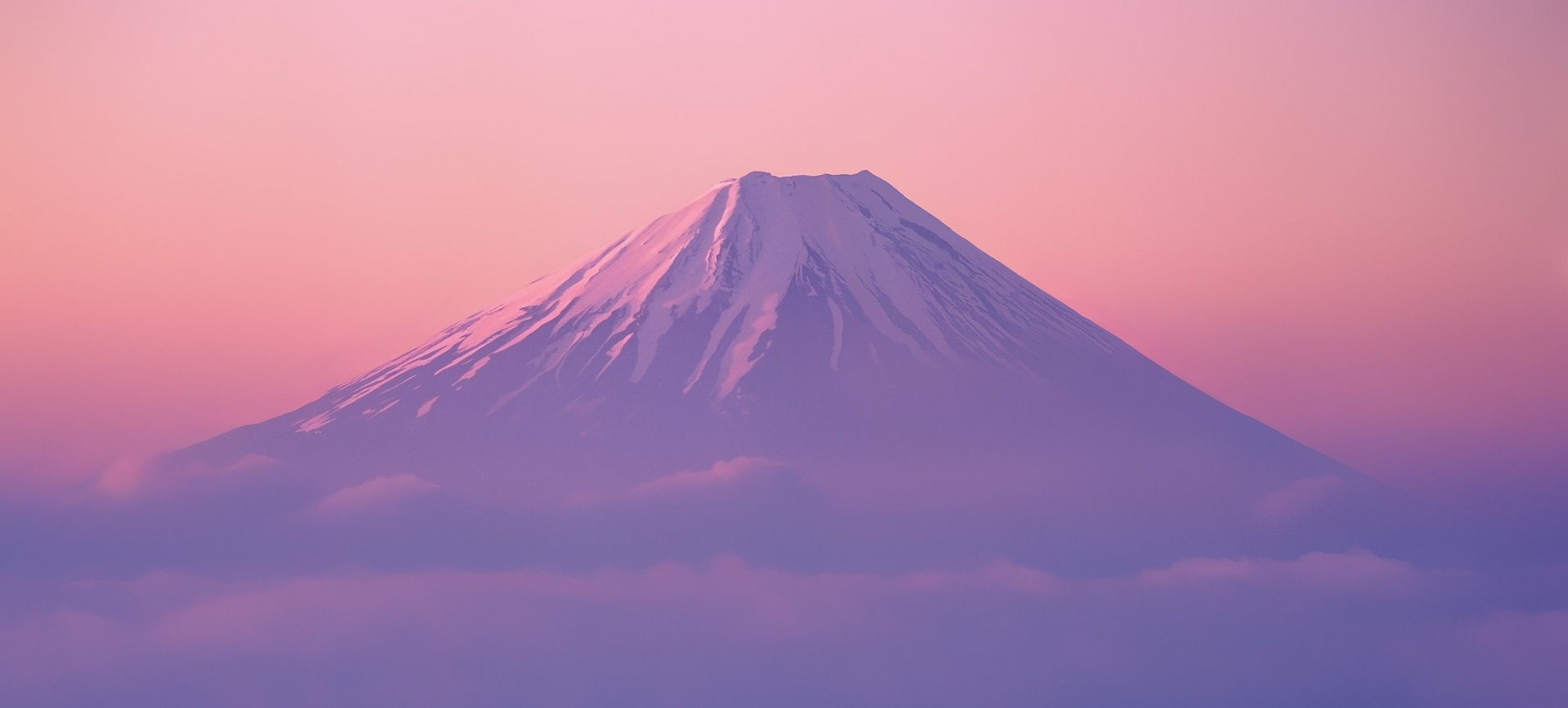ここでは五節句それぞれの意味や行事、節句の特別な食などについてお伝えします。
Here, I will tell you about the meanings and events of each of the five seasonal festivals, as well as special foods for each festival.
1月7日:人日の節句(じんじつのせっく)
古代中国の習慣に由来するといわれます。
1月1日から各日に動物を当てはめ占いを行うと同時に、その日はそれぞれの動物を大切にするというもの。7日目は人の日(つまり人日)で、この日は処刑を行わなかったのだとか。
この中国の風習と、日本の「7種類の野草を入れたお粥を食べ、その年の無病息災を祈る」風習が一緒になり、現在の人日の節句(じんじつのせっく)につながったと考えられています。
七草粥(ななくさがゆ)の日、の方がピンとくるかもしれません。
Jinjitsu-no-Sekku
It is said to originate from ancient Chinese customs.
Starting from January 1st, fortune-telling is performed by matching an animal to each day, and at the same time, each animal is valued on that day.The seventh day was People’s Day, and no executions were carried out on this day.
This Chinese custom and the Japanese custom of “eating porridge with seven herbs and praying for good health for the year” came together to form the current Jinjitsu no Sekku.
Nanakusagayu Day may be more relevant.
食:Special Food
七草粥(ななくさがゆ)/seven spring-herb rice porridge

春の七草(はるのななくさ)
芹(せり)・薺(なずな)・御形(ごぎょう)・繁縷(はこべら)・仏の座(ほとけのざ)・菘(すずな)・蘿蔔(すずしろ)
Seven Herbs
Seri (Water Dropwort/Japanese Parsley)・Nazuna (Shepherd’s Purse)・Gogyou (Cudweed)・Hakobera (Chickweed)・Hotokenoza (Henbit,Nipplewort)・Suzuna (Turnip)・Suzushiro (Daikon,Radish)

3月3日:上巳の節句(じょうしのせっく)
古代中国で3月最初の巳の日に行われていた「川で身を清め、不浄を祓う」習慣が由来といわれています。この習慣が日本に伝わり、宮中行事の「曲水の宴」へと形を変えていきました。
また、この日に紙で作った人形(ひとがた)を川に流すことで穢れを祓う「流し雛(ながしびな)」の行事も行われました(現代でもこの風習が残る地域があります)
時代とともに、流し雛としての人形(ひとがた)から雛人形(ひなにんぎょう)へと、その姿を変えていきます。この雛人形は、人に代わって厄(やく)を引き受けるという側面があり、そこから「女の子の健やかな成長と幸せを願う日」になったと考えられています。
現在では、雛祭り(ひなまつり)の日として知られています。また地域によっては「草餅(くさもち)の節句」として、邪気を払う蓬(よもぎ)と一緒についた草餅をいただく風習もあります。

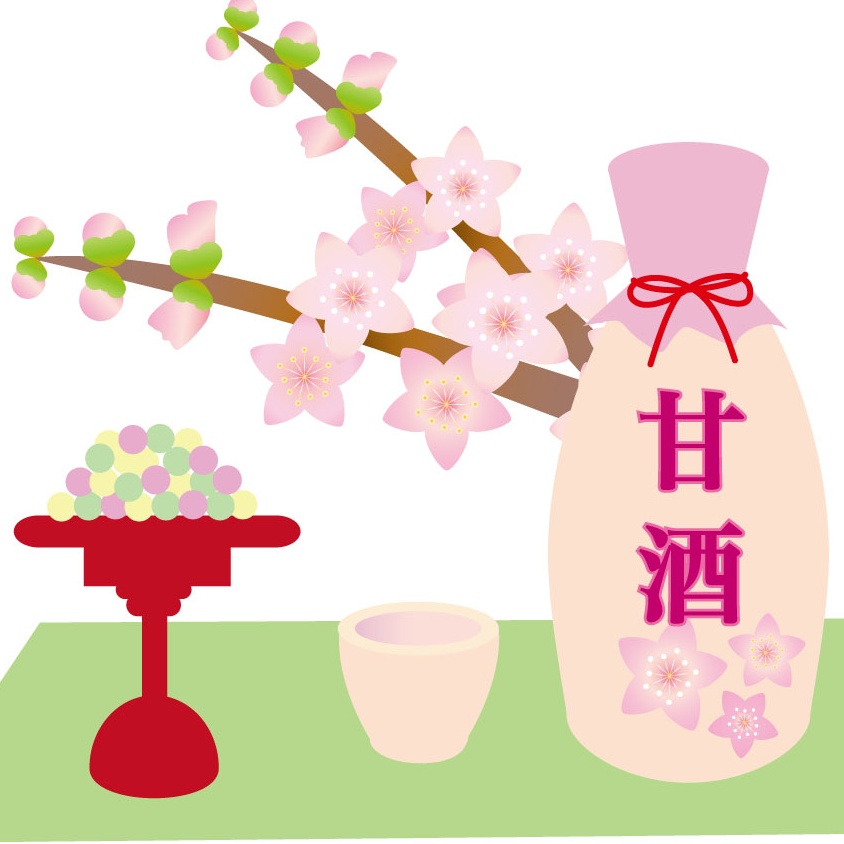
Jyoshi-no-Sekku(Girl’s Festival)
It is said to originate from the ancient Chinese custom of “purifying oneself in the river to exorcise impurity” on the first Snake Day in March. This custom was introduced to Japan and transformed into the “Kyokusui Banquet,” an event held in the imperial court.
Also, on this day, the “nagashibina” event was held, in which paper dolls (hitogata) were floated down the river to exorcise impurity (there are areas where this custom still remains even today).
Over time, the shape of Hina dolls changed from Hitogata to Hina dolls. These hina dolls have the aspect of taking on evil spirits on behalf of others, and it is believed that this is why the day is said to be “a day to pray for the healthy growth and happiness of girls.”
Today, it is known as Hinamatsuri(Girl’s Festival). Additionally, in some regions, there is a custom called the Kusamochi Festival, where people eat Kusamochi made by mugwort, which wards off evil spirits.
食:Special Foods

雛霰(ひなあられ)/Hina hail
菱餅(ひしもち)/Hishimochi
白酒(しろざけ)/Shirozake
蛤(はまぐり)のお吸い物/Clam soup
ちらし寿司/Chirashi sushi
雛霰(ひなあられ)/Hina hail
あられ餅、餅米、大豆などを炒って、砂糖を絡めて色をつけた菓子
3色のもの、4色のものがありますが、どちらも「女の子の健やかな成長」を願うものです。
3色の雛あられを構成する色は緑・赤・白です。緑は新芽が広がる大地や芽吹きを連想させることから、健康や生命力・エネルギーを表します。血や命を連想させる赤は生命のエネルギー、白は雪で覆われた大地という意味
雛あられの意味は色によって異なる! 色ごとの意味や雛祭りに食べる理由を解説(Oggi)
4色の雛あられは赤・緑・黄・白で構成されており、それぞれの色が四季を表しています。具体的には、花をイメージさせる赤=春、新芽を思わせる緑=夏、紅葉を連想させる黄=秋、雪につながる白=冬という意味
雛あられの意味は色によって異なる! 色ごとの意味や雛祭りに食べる理由を解説(Oggi)
A confectionery made by roasting arare mochi, glutinous rice, soybeans, etc. and adding sugar to give it its color
There are three-colored and four-colored ones, and both wish for the healthy growth of girls.
『The colors that make up the three-colored Hina Arare are green, red, and white. Green represents health, vitality, and energy because it is associated with the earth and budding sprouts. Red, which is associated with blood and life, is the energy of life, and white means the earth covered with snow.』
『The four-colored Hina Arare consists of red, green, yellow, and white, and each color represents the four seasons. Specifically, red, which reminds us of flowers, means spring; green, which reminds us of new buds, means summer; yellow, which reminds us of autumn leaves, means autumn; and white, which reminds us of snow, means winter.』
関東ではお米(ポン菓子)に甘い味付けのものが、関西ではおかきに塩気の味付けをしたものが主流だといわれています。
It is said that in the Kanto region, rice (popped rice) with a sweet flavor is the norm, while in the Kansai region, okaki with a salty flavor is the mainstream.
菱餅(ひしもち)/Hishimochi
もともとは菱(ひし)の実を粉にしてついた餅
(多くは)緑・白・赤(桃)の3色の菱形の餅を重ねたもの。
大きさは均等にする場合と、上の重ねほど小さくする場合がある。重ね方や色のあわせ方は地方により異なっている
日本大百科全書
その意味にも諸説ありますが
下の緑は草(ヨモギ)を表し邪気を払う、真ん中の白は(清浄さ)子孫繁栄、上の紅は桃の花(魔除け)を表している
五節句と行事食について(京都 美濃吉)
といわれています。
Originally a rice cake made from powdered rhombus fruit.
(Mostly) diamond-shaped rice cakes in three colors: green, white, and red (peach) are stacked on top of each other.
『The size may be uniform, or the size may be smaller as the layers overlap. The method of layering and color matching differs depending on the region.』
There are various theories about its meaning.
It’s said like this
『The green at the bottom represents grass (wormwood) and wards off evil spirits, the white in the middle represents (purity) and prosperity of descendants, and the red at the top represents peach blossoms (amulet).』
白酒(しろざけ)/Shirozake
もともとは男女の区別なく、邪気を払う行事だった「上巳の節句」
白酒には「厄払い」「不老長寿」という意味があるといわれます。
ただ白酒はお酒で子どもたちが口にすることはできないので、代わりに甘酒をいただく風習もあります。(赤いお顔の右大臣~🎵になってしまいますから 笑)

“Jyomi no Sekku” was originally an event to ward off evil spirits, regardless of gender.
Shirozake is said to have the meaning of “warding off evil spirits” and “eternal youth and longevity.’’
However, since baijiu is alcoholic and children cannot drink it, there is a custom of having amazake instead.
蛤(はまぐり)のお吸い物/Clam soup
「二枚貝の蛤(はまぐり)は、対になっている貝とはぴったり合い、他の貝では隙間ができる」ということから「夫婦和合(ふうふわごう)=一人の伴侶と末永く暮らす」という願いが込められているといわれます。
*貝合せ(かいあわせ)の遊びにも、蛤(はまぐり)の貝殻が用いられます
“A clam, a bivalve, fits perfectly with its partner, while leaving a gap with other shells,” which is the origin of the wish for “fufuwagou” (living with one partner for a long time).
*Clam shells are also used in the game of kaiawase.


ちらし寿司/Chirashi sushi
お祝いの席で用いられることの多い「寿司」
最近ではバリエーション豊かですが、腰が曲がるまで…と長寿を願う「海老」、先の見通しがよい「蓮根(れんこん)」、金銀に見立てた「錦糸卵」というおめでたい具材が使われます。
ほかに、健康でまめまめしく働ける「豆」根を張る「人参」などを加えたものに、季節の菜の花、桃の花を連想させる田麩(でんぶ)を散らしたものが多く見受けられます。
“Sushi” is often used at celebratory occasions
Nowadays, there are many variations, but the auspicious ingredients are “shrimp”, which prays for a long life until your back bends, “lotus root”, which gives you a good outlook, and “kinshi tamago”, which looks like gold and silver.
In addition, you can often find “beans” for healthy and diligent work, “carrots” for roots, etc., and sprinkled with denbu, which is reminiscent of seasonal rape blossoms and peach blossoms.
5月5日:端午の節句(たんごのせっく)
端午(たんご)は「端五」とも書かれるように、「月の初めの五日」を指す言葉
また旧暦五月は「午(うま)の月」*
五と午が同じ「ご」という音であることから「端午の節句」と呼ばれるようになったと言われています(諸説あり)
旧暦五月=午の月。1月から12月までの順番を意味する十二支(参考:十干・十二支・干支「干支とは?」)となれば、始まりの「子(ね)の月」が1月となりそうですが
①古代中国で、冬至のある月に北斗七星の取っ手の先が北を指すのでこの月(太陰暦11月)を子月(しげつ)とした
②漢王朝が、夏(か)の時代の正月(寅の月=立春正月)を採用したものが現代まで続いている
と言われ、それぞれ子(11)丑(12)寅(1)卯(2)辰(3)巳(4)午(5)・・・という月に相当します。
参考 国立天文台「三正論」
Tango no Sekku(Boy’s Festival)
Tango(端午) (also written as “端五”) is a word that refers to the first five days of the month.
Also, May in the lunar calendar is the “month of the horse”*
It is said that it came to be called “Tango no Sekku” because the words “go五” and “go午” have the same sound (go) (there are various theories).
May of the lunar calendar = Horse month.Twelve signs of the zodiac, meaning the order from January to December (Reference: Ten Zodiac Signs, Zodiac Signs, Zodiac Signs “What are the Zodiac Signs?”)If that’s the case, it seems that the beginning of the month, “month of rat,” will be January.
①In ancient China, the tip of the handle of the Big Dipper pointed north in the month of the winter solstice, so this month (November in the lunar calendar) was called the latch month.
②The Han Dynasty adopted the New Year’s Day of the Xia Dynasty (Tiger Moon = New Year’s Day of Spring), which has continued to the present day.
They correspond to the following months: rat (11), ox (12), tiger (1), rabbit (2), dragon (3), snake (4), horse (5), etc.
端午の節句の風習/Customs of Tango no Sekku(Boy’s Festival)
古代中国で行われていた「山野で薬草を摘み、菖蒲(しょうぶ)酒を飲んで邪気を払う」行事が日本に伝わり、広まっていったと言われています。日本では「田植えをする早乙女(さおとめ)が、身を清め、田の神さまを迎え祀る」という風習があり、それらが一緒になったと考えられています。
①薬草の一種である菖蒲(しょうぶ)を入れた薬湯(やくとう)=菖蒲湯(しょうぶゆ)に浸かり、邪気を払う
菖蒲は、尚武(しょうぶ)=武道・武勇を重んじることに通じること、五月の印地打(いんじうち)=石合戦などから、江戸時代にこの日を「尚武(しょうぶ)の節句」と定めたとされています。
②上巳(じょうし)の節句の節句が、次第に雛人形を飾る女の子の節句と形を変えていくこともあり、端午の節句は、男の子の節句として甲冑(かっちゅう)や武者人形(むしゃにんぎょう)を飾る
③鯉幟(こいのぼり)を立てる
中国の故事「鯉は竜門の滝を登って竜となる」にちなみ、立身出世(りっしんしゅっせ)の願いが込められている
*旧暦の5月5日は、現代の梅雨の時期。雨の鯉のぼりを「登竜門」に見立てたもの



It is said that the ancient Chinese event of “picking medicinal herbs in the mountains and drinking iris wine to ward off evil spirits” was introduced to Japan and spread there.In Japan, there is a custom in which “Saotome, who is planting rice, purifies herself and welcomes and worships the god of rice fields,” and it is thought that these two practices came together.
①Soak in shobuyu, a medicinal bath containing iris, a type of medicinal herb, to ward off evil spirits.
In the Edo period, this day was called the “Shobu no Sekku” because the Shobu=irises are associated with respecting martial arts and valor, and injiuchi (stone battles) in May. It is said that it was established.
②Joshi no Sekku gradually changed its form to a girls’ festival where dolls are displayed, and Tango no Sekku is a boy’s festival where armor and warrior dolls are displayed.
③Put up carp-shaped streamer
it is based on the Chinese story “A carp climbs the Dragon Gate Waterfall and becomes a dragon,” and it symbolizes the wish for success in life.
*May 5th in the lunar calendar is the modern rainy season. Carp-shaped streamer in the rain that resembles a “gateway of success”

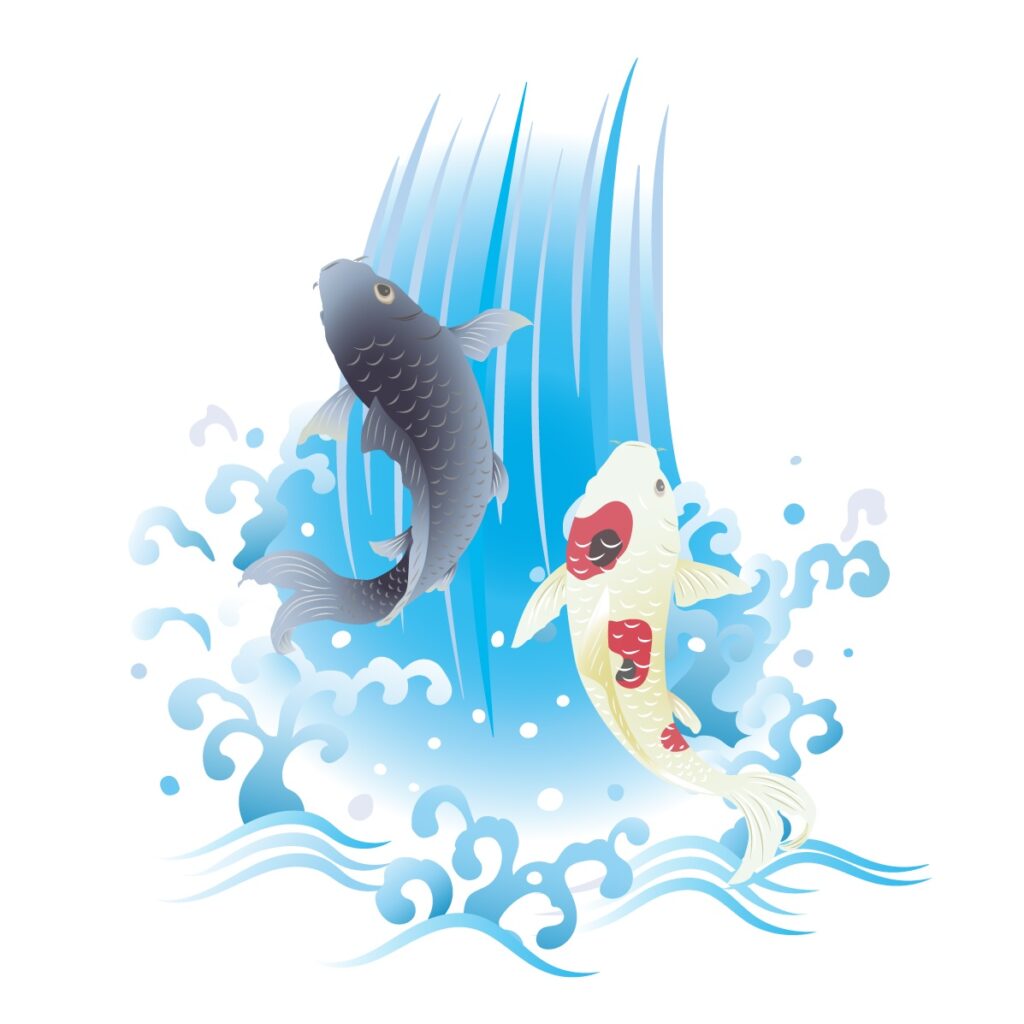
食:Special Foods

粽(ちまき): Chimaki
柏餅(かしわもち):Kashiwa mochi
粽(ちまき)/Chimaki
中国発祥
由来は諸説あり、ここでは2つご紹介します。
1)中国「楚」の政治家、詩人「屈原(くつげん)」の供養
楚の王族であった屈原は、博識の上政治的手腕にも優れていたため、王に信任されて要職に就きます。しかし他の官僚の妬みにあい失脚(中略)王に見放された屈原は、楚の未来を憂いつつ汨羅(べきら)の淵に身を投げ、失意のうちにその一生を終えました。
その死を悼んだ里人は、命日の5月5日に供養として竹筒に米を入れ、汨羅の淵に投げ込みます。しかしある時、屈原の霊があらわれ、こう訴えました。“淵には蛟龍(こうりゅう=龍の一種)が住んでおり、投げ込んだ供物を食べてしまう。厄除けに楝樹(せんだん)の葉で包み、五色の糸で巻けば蛟龍は食べないであろう”
屈原と粽(とらや)
これが現在の粽(ちまき)の原型だといわれています。
2)古代中国の「寒食(かんしょく)=火を使わずに作った料理を食べる」風習の名残
冬至から105日目に、火気を用いないで冷たい食事をしたこと。そのころは風雨が激しいので火災予防のためとも、また、一度火を断って新しい火で春を促すためともいう。
デジタル大辞泉

Chimaki:steamed glutinous rice dumpling wrapped in bamboo leaf
Originated in China
There are various theories about its origin, and I will introduce two here.
1)Memorial service for Qu Yuan, a politician and poet of Chu in China
“As a member of the royal family of Chu, Qu Yuan was knowledgeable and had excellent political skills, so he was trusted by the king and held important positions. However, due to the jealousy of other bureaucrats, Qu Yuan was abandoned by the king, and, worrying about the future of Chu, Qu Yuan threw himself into the depths of the Pilgrimage and ended his life in despair. ”
“The villagers who mourned his death filled a bamboo tube with rice and threw it into the depths of the Bekira as a memorial service on May 5th, the anniversary of his death. However, one day Qu Yuan’s spirit appeared and complained: “Koryu (a type of dragon) lives in the deep, and eats the offerings you throw into it. To ward off evil spirits, wrap it in Sendan leaves and wrap it in five-colored thread to prevent the Koryu from eating it.”
This is said to be the origin of today’s chimaki.
2)Remnants of the ancient Chinese custom of eating cold food (eating food prepared without using fire)
“On the 105th day after the winter solstice, they ate cold meal without using fire. This is said to be done to prevent fires as the wind and rain are intense at that time, and also to encourage spring with a new fire after extinguishing the fire.”
柏餅(かしわもち)/Kashiwa mochi
日本発祥
縁起のよい*柏の葉で餅をくるんだもの
柏の木は「新芽がふくころまで、古い葉が落ちない=子孫繁栄(しそんはんえい)・元気に育つ」「古来より神事に用いられたきた」ので縁起がよいから
また「餅を包むときの手つきが、柏手(かしわで)を打つときの動作に似ている」から

Kashiwa mochi:rice cake filled with sweet bean paste wrapped in oak leaf
Originated in Japan
A rice cake wrapped in an oak leaf that is said to be fortunate
The oak tree is said to be auspicious because “the old leaves do not fall until the new buds begin to bloom = offspring will prosper and grow vigorously” and “it has been used in Shinto rituals since ancient times.’’
Also, “the motion you make when wrapping mochi is similar to the motion you make when clapping your hands.”
7月7日:七夕の節句(しちせきのせっく)
七夕(しちせき)
旧暦七月七日の夜。この夜、天上の「織女(しょくじょ)」(織姫/おりひめ)と「牽牛(けんぎゅう)」(彦星/ひこぼし)は、天の川を渡って、年に一度の逢瀬(おうせ)を楽しむ。この夜、雨が降れば、天の川が増水して二人は逢えない。この二人の逢瀬を「星合」「星の恋」ともいう。
織姫は天の川の北岸、琴(こと)座のベガ(織女星)、牽牛は南岸の鷲(わし)座のアルタイル(牽牛星)である。二人は舟で天の川を渡って逢うとも、鵲(かささぎ)が羽を連ねた「鵲の橋」を渡って逢うともいう。
地上では、星の恋の成就を祈り、また、裁縫や習字がうまくなるよう願って、短冊を「七夕竹」に飾るなど、七夕の祭が行なわれる。
この七夕祭は日本と中国の行事が合体してできあがった。一つは、古代日本の夏越の祓(なごしのはらえ)(旧暦六月末日)から続く禊(みそぎ)の行事。これに、中国から伝わった七夕伝説と、裁縫の上達を願う「乞巧奠(きっこうでん)」の風習が重なった。
日本の歳時記
このように日本と中国の風習が一緒になり、現在の七夕(しちせき)の形になりました。一般的には「たなばた」として知られています。



Shichiseki /Tanabata= Star festival
The night of the seventh day of the seventh month of the lunar calendar. On this night, the heavenly “Shokujo” (Orihime) and “Kengyu” (Hikoboshi) cross the Milky Way and enjoy their once-a-year meeting. If it rains that night, the Milky Way will rise and the two will not be able to meet. The meeting between these two people is also called “Hoshiai” or “Star Love.’’
Orihime is located on the north bank of the Milky Way, Vega (star of the weaving woman) in the constellation Lycora, and Kengyu is located on the south bank of the Milky Way, Altair (star of the cow) in the constellation Eagle. It is said that the two meet by crossing the Milky Way on a boat, or by crossing the “Kasasagi no Bridge,” a bridge made of magpies with their wings tied together.
On earth, Tanabata festivals are held, with strips of paper placed on “Tanabata bamboo” to pray for the fulfillment of star love, and to pray for improved sewing and calligraphy skills.
This Tanabata Festival was created by combining Japanese and Chinese events. One is the misogi event that has continued since ancient Japan’s summer exodus (Nagoshi no Harae) (the last day of June in the lunar calendar). This overlapped with the Tanabata legend that came from China and the custom of “Kikkoden” to pray for improved sewing skills.
In this way, the customs of Japan and China came together, resulting in the current form of Tanabata (Shichiseki).It is commonly known as “Tanabata”.
七夕の風習/Customs of Shichiseki no Sekku (Tanabata)
七夕飾り/Tanabata decoration
願い事を書いた短冊や、折り紙などで作った飾りを笹竹に下げます。
Hanging strips of paper with wishes written on them and decorations made from origami etc. to the bamboo.
短冊
「五色の短冊(ごしきのたんざく)~🎵」と「たなばたさま」の歌にあるように、5色が基本。赤・青・黄・白・黒(紫)は、陰陽五行説に由来するものです。
機織り(はたおり)が上手な織姫(おりひめ)にあやかり、手芸や詩歌、文字の上達を願っていたものが、時代とともにさまざまな願いごとを託すようになりました。
七夕の翌日には、災厄や穢れを祓うため、七夕飾りを川や海に流す風習がある。これを七夕送り、七夕流しともいう
平成ニッポン生活便利帳
飾り
吹き流し・網(あみ)飾り・衣(ころも)・輪つなぎ・星飾りなど



Strip of paper
“Goshiki no Tanzaku ~🎵” As the song by Tanabata-sama says, five colors are the basics. Red, blue, yellow, white, and black (purple) originate from the theory of Yin-Yang and the Five Elements.
People used to pray for improvement in handicrafts, poetry, and writing in memory of Orihime, who was a skilled weaver, but as time passed, various wishes came to be entrusted to her.
『The day after Tanabata, there is a custom of throwing Tanabata decorations into rivers and the sea to ward off misfortune and impurity. This is also called Tanabata Okuri or Tanabata Nagashi.』
Decorations
Streamers, net decorations, robes, ring ties, star decorations, etc.


七夕祭り/ Tanabata Festival
旧暦7月7日やお盆前後に開催される七夕祭り
地方色豊かな祭りが開かれます
Tanabata Festival is held on July 7th of the lunar calendar and around Obon.
A festival with a rich local flavor will be held.


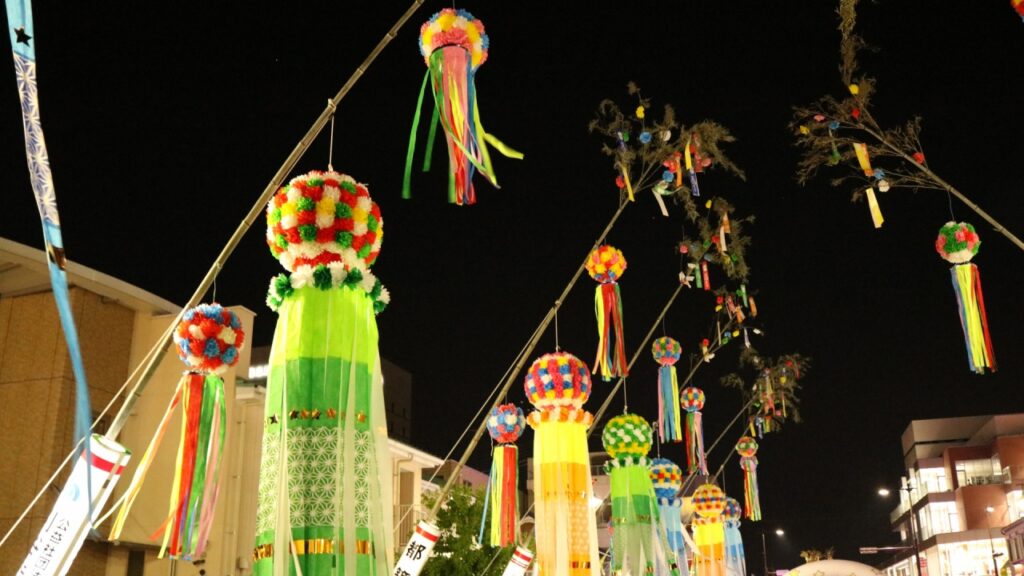

食:Special Food
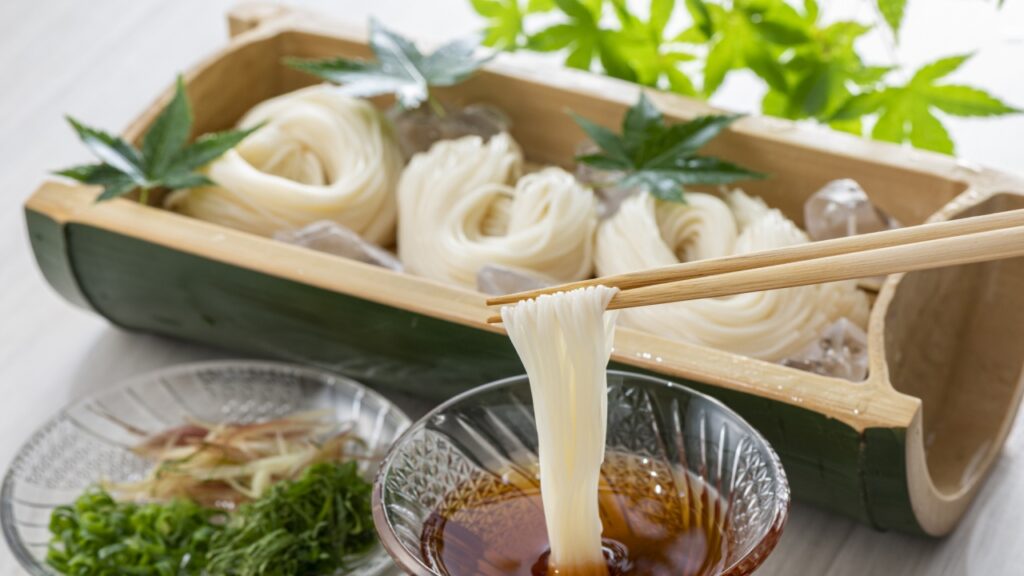
素麺(そうめん)/Somen
小麦粉でつくる細い乾麺/Thin dried noodles made from wheat flour
初めの名前は「索麺 (さくめん) 」であるが、索の字を崩して書いたのが素の字とみられ、素麺と誤記したのがそのまま名称となったのである。中国から渡来したが、その時期は奈良時代とみられている。
日本大百科全書
The original name was “Sakumen”, but it seems that the original character was written by breaking the character “Sakumen”, and it was miswritten as “Somen”, which became the name. It was brought to Japan from China, and is believed to have been introduced during the Nara period.
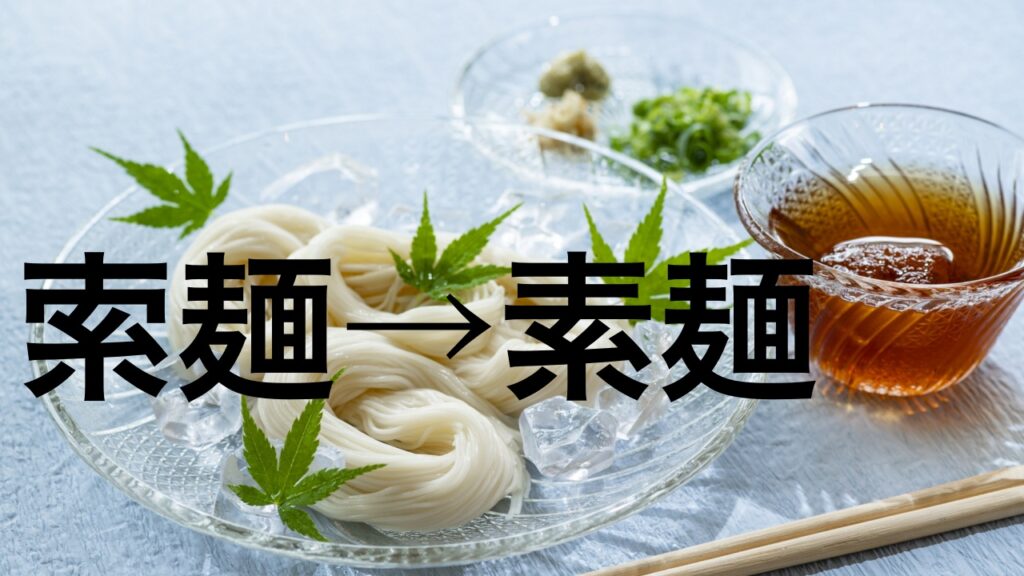
9月9日:重陽の節句(ちょうようのせっく)
陽の数字9が月・日ともに重なる佳日(かじつ)であることから、重陽(ちょうよう)と呼ばれる
菊の花で邪気(じゃき)を払う
旧暦9月9日は十三夜(栗明月・豆明月)の4日前。現代では10月もしくは11月にあたり、菊の花が咲くころから「菊の節句」とも呼ばれます。

地方により風習が異なり
東北地方では、9日だけでなく19日・29日をあわせて、サンクニチまたはミクニチと称し、どの日かに重点を置いて餅 を搗 (つ)き、刈上げを祝う所が多い。
長野県上伊那 (かみいな) 地方では、9日を神の日、19日を百姓の日、29日を町人の日などといって祝った。
静岡県西部では好きなだけ食べる日とされ、「九月クンチの腹太鼓」などといっていた。
九州北部では、長崎市の諏訪 (すわ) 神社をはじめ秋祭をオクンチと称して、この日(現在では10月9日)を祭日としている所が多い。
日本大百科全書
Cyouyou no Sekku(Chrysanthemum Festival)
It is called Chouyo because the positive number 9 is a good day when both the month and day overlap.
Get rid of evil spirits with chrysanthemum flowers.
September 9th of the lunar calendar is four days before the 13th night (Chestnut Meigetsu, Bean Mingetsu). In modern times, it falls in October or November, and is also called the “Chrysanthemum Festival” because of the time when chrysanthemums bloom.

Customs vary depending on the region
『In the Tohoku region, not only the 9th but also the 19th and 29th are called Sanku-nichi or Mikunichi, and in many places they celebrate the harvest by pounding mochi with emphasis on which day.
In the Kamiina region of Nagano Prefecture, the 9th was celebrated as God’s Day, the 19th as Peasants’ Day, and the 29th as Townsman’s Day.
In the western part of Shizuoka Prefecture, it was considered a day to eat as much as you wanted, and people called it “September Kunchi Belly Drum.’
In northern Kyushu, many places, including Suwa Shrine in Nagasaki City, call the autumn festival Okunchi, and observe this day (currently October 9th) as a holiday. 』
重陽の風習/ Customs of Cyouyou no Sekku

観菊会(かんぎくかい)/Chrysanthemum viewing party
被せ綿(きせわた)/Covered cotton (Kisewata)
菊枕(きくまくら)/Kikumakura, Dried chrysanthemum flowers pillow
観菊会(かんぎくかい)/Chrysanthemum viewing party
菊の花を鑑賞する
Admire chrysanthemum flowers
被せ綿(きせわた)/Covered cotton (Kisewata)
漢方薬としても用いられる菊の花
長寿を願い、前日9月8日の夜に菊の花に被(かぶ)せた綿に沁み込んだ露で体を拭(ぬぐ)う
Chrysanthemum flowers are also used as Chinese medicine
Wishing for a long life, people wiped thier body with the dew soaked through the cotton that they had covered the chrysanthemums on the night before, September 8th.
菊枕(きくまくら)/Kikumakura, Dried chrysanthemum pillow
菊の香りには邪気を払う力があると考えられており、乾燥させた菊の花を詰めた枕で眠る
The scent of chrysanthemums is believed to have the power to ward off evil spirits, and people sleep on pillows stuffed with dried chrysanthemum flowers.
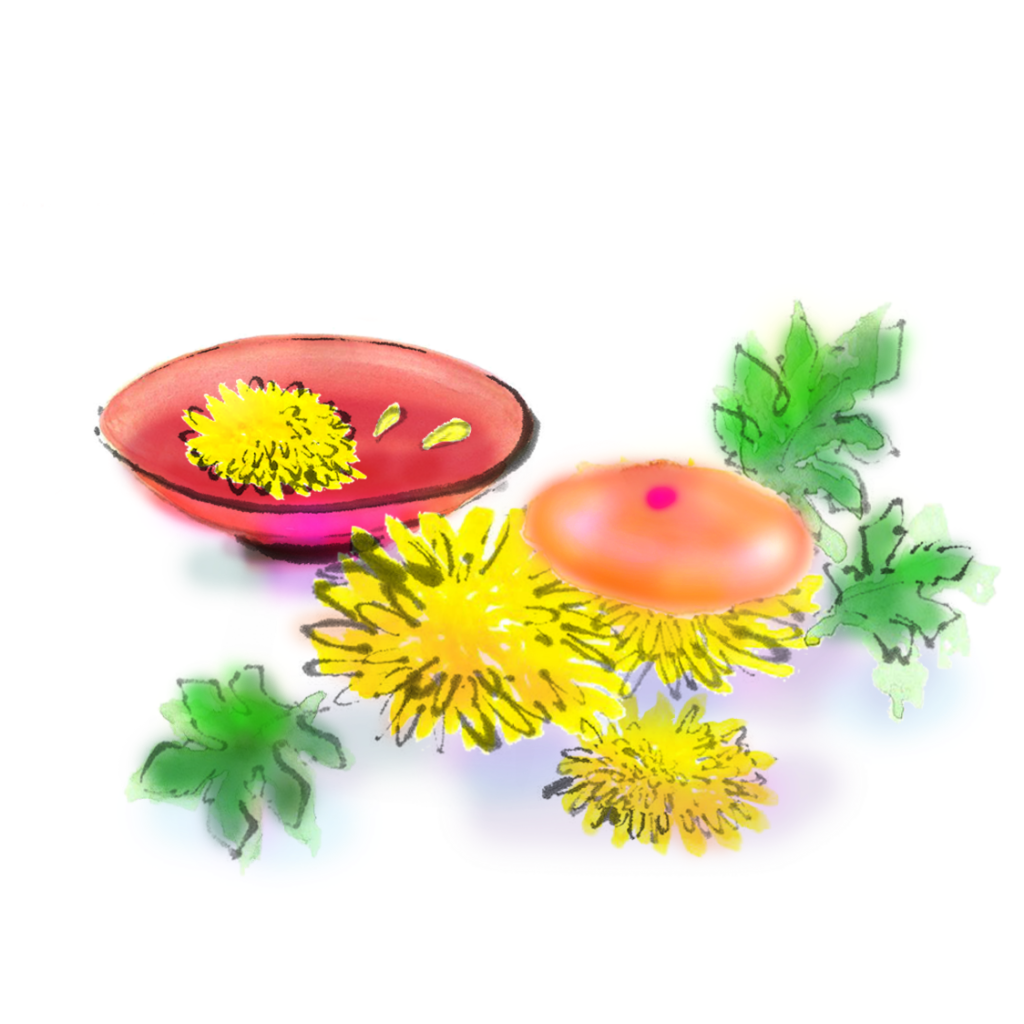


食:Special Foods
菊や栗を使ったもの
Made with chrysanthemums and chestnuts

菊酒(きくしゅ)/Chrysanthemum Sake
菊茶(きくちゃ)/Chrysanthemum tea
栗ご飯(くりごはん)/Chestnut rice
蒸し栗(むしぐり)/Steamed chestnuts
菊酒(きくしゅ)/Chrysanthemum Sake
日本酒に菊の花を漬け込む、あるいは菊の花びらを浮かべて長寿を願っていただく
Soak chrysanthemums in sake or float chrysanthemum petals to pray for longevity.
菊茶(きくちゃ)/Chrysanthemum tea
乾燥させた菊の花にお湯を注ぎ、お茶としていただく
Pour hot water over dried chrysanthemum flowers and enjoy as tea.
栗ご飯(くりごはん)/Chestnut rice
蒸し栗(むしぐり)/Steamed chestnuts
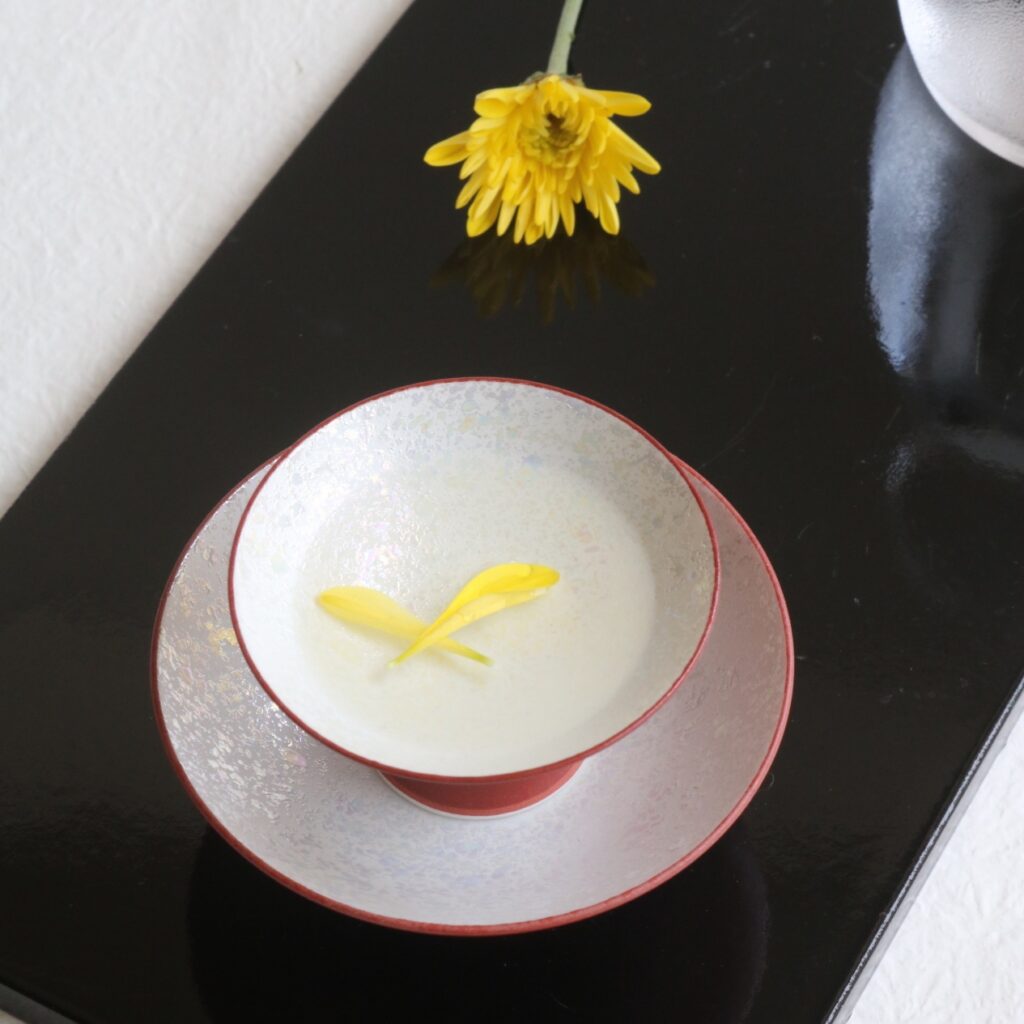


その他/Others
後の雛(のちのひな)/Later Hina Dolls

上巳の節句(じょうしのせっく)で飾った雛人形を、虫干しを兼ねてふたたび飾る風習
The custom of displaying Hina dolls decorated for the Joshi no Sekku festival again to dry insects.
*この時は、夫婦雛(めおとびな)のみ飾る
At this time, only the married couple’s dolls (Meotobina) will be displayed.
**地域によっては、旧暦8月朔日(ついたち):八朔(はっさく)に飾る
In some regions, it is decorated on Hassaku, the first day of the eighth month of the lunar calendar.
参考サイト 9月9日にお雛さま?「後の雛」って一体何?
